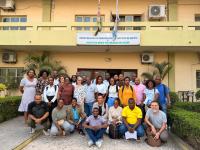Congenital anomalies are the second-leading cause of death in children under 5 in the Americas

To raise awareness about the impact of congenital anomalies, the Pan American Health Organization/World Health Organization (PAHO/WHO) has joined with 11 other leading global health organizations to commemorate the first World Birth Defects Day (3 March).
Birth defects, also called congenital anomalies, congenital disorders or congenital malformations, are the second-leading cause of death in infants 28 days or younger and in children under 5 in the Americas. Combined with prematurity, asphyxia and sepsis, birth defects account for 44% of deaths among children. Globally, birth defects affect 1 in 33 babies and cause 3.2 million disabilities each year.
"The commemoration of this day aims to raise awareness about this common, costly and challenging problem but also to foster the development and implementation of prevention programs and to expand healthcare services for all people with birth defects," said Suzanne Serruya, Director of PAHO/WHO's Latin American Center for Perinatology (CLAP).
Congenital anomalies can have genetic, infectious or environmental origins, although in most cases it is difficult to identify a cause. The most common serious birth disorders are heart and neural tube defects and Down syndrome.
Each year, an estimated 270,000 newborn babies die in the first 28 days of life from congenital anomalies, which are the fourth-leading cause of neonatal deaths after complications of premature delivery, neonatal infections and complications of childbirth, according to WHO data.
For babies who survive and live with these conditions, birth defects increase their risk of long-term disabilities, which greatly impact the individuals affected, their families, health systems and society.
Many birth defects can be prevented or treated. Sufficient folic acid and iodine consumption during pregnancy, vaccination against rubella (which can be transmitted to children during pregnancy) and proper prenatal care are all key prevention measures.
"Our vision is for every child to be born with the best health possible and with the potential for a full and productive life," said the 12 sponsoring organizations in a joint statement.
In addition to PAHO/WHO, sponsors of World Birth Defects Day include the U.S. Centers for Disease Control and Prevention (CDC); the Latin American Collaborative Study of Congenital Malformations (ECLAMC); the European Dysmelia Reference Information Centre (EDRIC); the International Federation for Spina Bifida and Hydrocephalus (IFSBH); the International Clearinghouse for Birth Defects; the March of Dimes; Alianza Neonatal; the National Birth Defects Prevention Network (NBDPN); the Partnership for Maternal, Newborn and Child Health; and the WHO Regional Office for South-East Asia.



